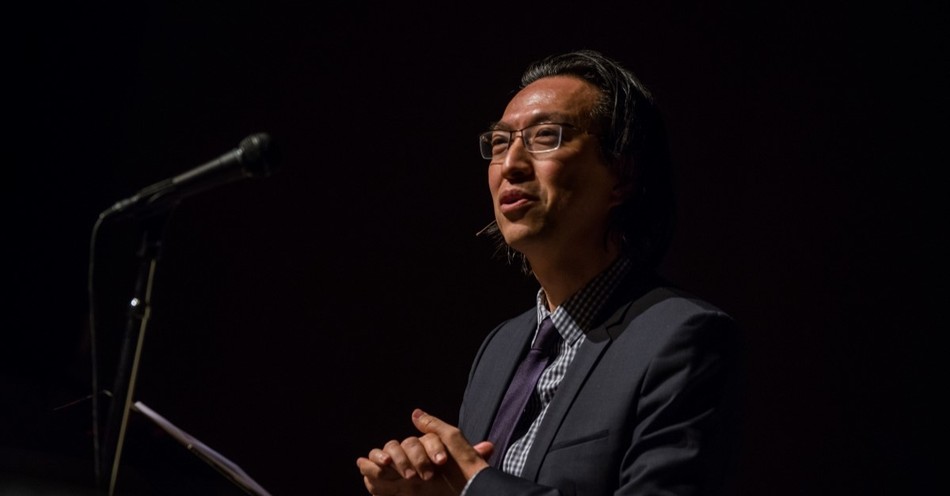Fujimura is an artist, writer, speaker, and Christian who is influential in both the Christian and secular art world. His art has been exhibited in various museums around the globe, and he writes and speaks on the theology and philosophy of creating art.
What Is Makoto Fujimura Known For?
As a writer, Fujimura conceived the term “culture care,” which describes a stewarding of culture (not just Christian culture) through beauty, creativity, and generosity—as a witness to the world but also as a custodian for future generations. He also coined the term “theology of making,” a reconciliation of art and faith and the spiritual act of making—a discipline through each day of awareness, waiting, prayer, and praise.
As an artist, Fujimura is known in much of his work for fusing fine art with abstract expressionism and the traditional Japanese art of bird and flower painting. Additionally, he has played a major role in the “slow art” movement, the proposition that art should be savored intentionally, not consumed quickly and carelessly. He deliberately uses slow techniques to preserve tradition as well.
Important Events in Makoto Fujimura’s Life
Fujimura was born in 1960 in Boston to parents of Japanese descent. His father, Osamu, was conducting research at MIT at the time of his birth. Osamu was a renowned physicist, phonetician, and linguist and one of the pioneers of speech science.
As a young child, Fujimura and his family moved back to Japan, where he spent his childhood. When he was 13, his family moved back to the United States. After high school, Fujimura studied art at Bucknell University. He completed a doctorate in traditional Japanese painting at the Tokyo University of the Arts in Japan.
In his book Silence and Beauty, Fujimura shares how he first discovered his Christian faith. He searched for a greater life purpose when he studied art in Tokyo. Eventually, he found meaning in Christianity through the poems of William Blake. He regularly incorporates his faith with his artwork.
In 1991, Fujimura started the organization IAMCultureCare to encourage faith-based people to create beauty and love one another amid brokenness.
Fujimara is married to Haejin Shim Fujimura, a lawyer and CEO of Embers International. Together, they promote creativity through the “Beauty+Justice” movement.
Throughout his career, his works have joined prominent museums’ permanent collections. Among others, his work can be seen at the National Modern Museum of Art in Tokyo, the Cincinnati Art Museums, and the CNN building in Hong Kong.
In 2011, he was commissioned by Crossway Publishing to illuminate the project The Four Holy Gospels to celebrate the four hundred anniversary of the first publishing of the King James Bible. The Four Holy Gospels consists of over 140 illuminated pages and has been displayed at the Museum of the Bible in Washington, DC.
Fujimura served as a special advisor for the 2016 epic historical drama Silence, directed by Martin Scorsese.
Fujimara has lectured at Princeton, Yale, Gordon College, and many other universities. He has also spoken at conferences worldwide.
How Does Christianity Inform Makoto Fujimura’s Work?
Fujimura has cultivated a robust theology that inspires his art and should inspire creativity, he argues, of all followers of Christ. He makes his case that God is not trying to restore us to Eden but creating a new, abundant garden for God’s Kingdom through us. He states that what we build, design, and create has eternal meaning and value.
Fujimura often references that the Bible describes God creating out of love, not necessity. He argues further that humanity was made to imitate God and that seeking beauty, truth, love, art, and grace all contribute to God’s glory. He cites Adam’s first task in the Garden of Eden was to be on a mission with God and name all the animals—an act of creativity. Thereare many examples of creativity in the Bible and God using it for his glory.
Fujimura encourages Christians to ask themselves and others, “What did they make each week?”
He highlights how this question should be asked out of humility and sacrifice unto God—otherwise, art can become an idol. Fujimura isn’t just emphasizing writing a song or painting a painting, but making a cup of coffee, decorating a room, conversing with a neighbor, or landscaping one’s lawn. He sees each day-to-day task as a making opportunity for God’s glory.
He sees himself and other artists like theologians as guides into experiencing and understanding truth. Artists can be witnesses in and outside the church. Fujimura often laments that the Gospel has been simplified to be communicated in the most efficient way possible—stemming from the industrial mindset of the modern world. He says imagination is necessary to bridge the cultural gap between the secular and the religious. Instead of being suspicious of art, Christians should embrace the arts to deepen their relationship with Christ and connect to the Christian community.
Like Michael Card and others, Fujimura reminds people that the Bible is interwoven with artistic expression, and the lives of current-day Christians should reflect that.
Great Makoto Fujimura Paintings to See
Walking on Water. An elegy to the 2011 victims of the great earthquake and tsunami in Japan. Starting in Feb. of 2023, it can be seen at the Martha Berry Museum.
Water Flames. Created in 2005, this series of paintings is based on Dante’s vision of his journey to Paradise via the Inferno and Purgatory. Later, one of the pieces became part of The Four Holy Gospels.
Silence. This series explores the hidden dimensions of beauty born of sacrifice and trauma, specifically the 250 years of Christian persecution in Japan. The series was born from Fujimura honoring his father’s legacy in the speech and hearing sciences and his experience reading Shusaku Endo’s masterpiece, Silence.
Ki-Seki. In Japanese, this means both “tree-mark” and “miracle.” This piece was inspired by an old tree on Fujimara’s farm outside Princeton. When he moved there, he was told it would never flower again. Instead, it blossomed beautifully—a representation of God’s power of resurrection.
Christmas 3020. This piece was conceived from Fujimura’s wonder of what Christmas will be like 1,000 years from now and his concern if beauty, justice, and love will still bind humanity together.
Inspiring Makoto Fujimura Quotes
“What if we committed to speaking fresh creativity and vision into culture rather than denouncing and boycotting other cultural products?” ― Culture Care
“When we cross borders culturally, we experience some alienation from our own culture and gain an objective perspective toward our own culture at the same time. A bicultural individual comes to identify home as a culture outside his or her original identity, and may vacillate in commitment and loyalty to both cultures.” ― Silence and Beauty
May we always be willing to present a bouquet of flowers, even to those who may not yet know that they desire beauty.” ― Culture Care
“In some sense, a broken marriage is due to the unresolved tension between two tribal identities. All marriages are cross-cultural, so a good therapist will help raise to the surface the issues and resources of each culture in the relationship and then help the two conflicting cultures come together as complements.” ― Culture Care
“If we care to know how deep the suffering of Christ goes—and how vast and even violent is the restoration process through Christ’s suffering—then we had better start with knowing the dark, cruel reality of the fallen world. If we care to embrace hope despite what encompasses us, the impossibility of life and the inevitability of death, then we must embrace a vision that will endure beyond our failures.” ― Silence and Beauty
Best Makoto Fujimura Books to Read
1. Art and Faith: A Theology of Making
2. Silence and Beauty: Hidden Faith Born of Suffering
3. Culture Care: Reconnecting with Beauty for Our Common Life
4. Refractions: A Journey of Art, Faith and Culture
5. On Becoming Generative: An Introduction to Culture Care
You can hear Fujimura saying more about his book Refractions in this GodTube video.
Fujimura has also contributed essays or forewords to these books:
1. Reading Buechner: Exploring the Work of a Master Memoirist, Novelist, Theologian, and Preacher by Jeffrey Munroe
2. Scribbling in the Sand: Christ and Creativity by Michael Card
3. Rembrandt Is in the Wind: Learning to Love Art through the Eyes of Faith by Russ Ramsey
4. It Was Good: Making Art to the Glory of God edited by Ned Bustard
5. The Soul of Desire: Discovering the Neuroscience of Longing, Beauty, and Community by Curt Thompson
6. Letters to a Future Church: Words of Encouragement and Prophetic Appeals edited by Chris Lewis
7. The Problem with The Dot: A Holistic Approach to Christians’ Care and Cultivation of Global Culture through the Theatrical Ecosystem by Bruce D. Long
8. God in the Modern Wing: Viewing Art with Eyes of Faith edited by Cameron J. Anderson and G. Walter Hansen
9. Aroma of Beauty: In the Wake of the 2011 Tsunami in Japan by Roger W. Lowther
10. The Sound of Life’s Unspeakable Beauty by Martin Schleske, translated by Janet Gesme
11. How to Heal Our Divides: A Practical Guide edited by Brian Allain
Further Reading:
What You Need to Know about Frederick Buechner
What Is Christian Art and Can It Be Better?
Evangelical Tracts and Real Art
Photo Credit: Roanoke College/Flickr
Nate Van Noord is from Detroit, MI, a graduate of Calvin University, and has taught high school history for many years. He loves to bike, run, and play pickleball, has been to about 30 countries, and is a three time winner of NPR's Moth Detroit StorySlam competitions.
This article is part of our People of Christianity catalog that features the stories, meaning, and significance of well-known people from the Bible and history. Here are some of the most popular articles for knowing important figures in Christianity:
How Did the Apostle Paul Die?
Who are the Nicolaitans in Revelation?
Who Was Deborah in the Bible?
Who Was Moses in the Bible?
King Solomon's Story in the Bible
Who Was Lot's Wife in the Bible?
Who Was Jezebel in the Bible?
Who Was the Prodigal Son?


_639003522088907085.jpg)
